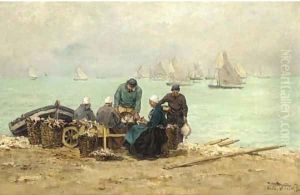Emile-Louis Vernier Paintings
Emile-Louis Vernier, born in 1829 and passing away in 1887, was a French artist renowned for his contributions to printmaking and engraving. His works are characterized by their detailed precision and the ability to convey intricate textures and shades, a testament to his mastery over the techniques of lithography and etching. Vernier's artistic journey was largely influenced by the vibrant cultural milieu of 19th-century France, a period that was marked by significant advancements in the arts and sciences, as well as by the tumultuous events of the era, such as the revolutions of 1848 and the Franco-Prussian War.
Vernier's oeuvre is notable for its diversity, ranging from landscapes and cityscapes to portraits and genre scenes, reflecting the artist's keen observation skills and his fascination with both the natural world and the bustling life of urban environments. His ability to capture the essence of his subjects with both realism and sensitivity won him accolades and recognition among his contemporaries. Despite the prevalence of painting during his time, Vernier remained devoted to the medium of printmaking, exploring its potential for artistic expression and communication.
Throughout his career, Vernier engaged with the artistic community in France and abroad, participating in exhibitions and contributing to the diffusion of printmaking techniques. His works were collected and admired not only in France but also internationally, showcasing the universal appeal of his artistic vision. After his death in 1887, Vernier's legacy continued to influence the field of printmaking, inspiring future generations of artists to explore the possibilities of the medium. Today, his prints are preserved in numerous museums and collections around the world, serving as a testament to his skill, creativity, and the enduring significance of his art.
